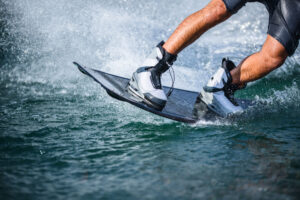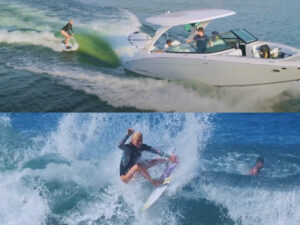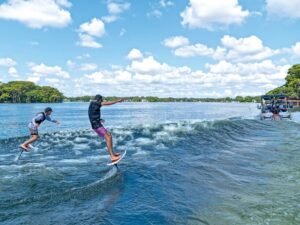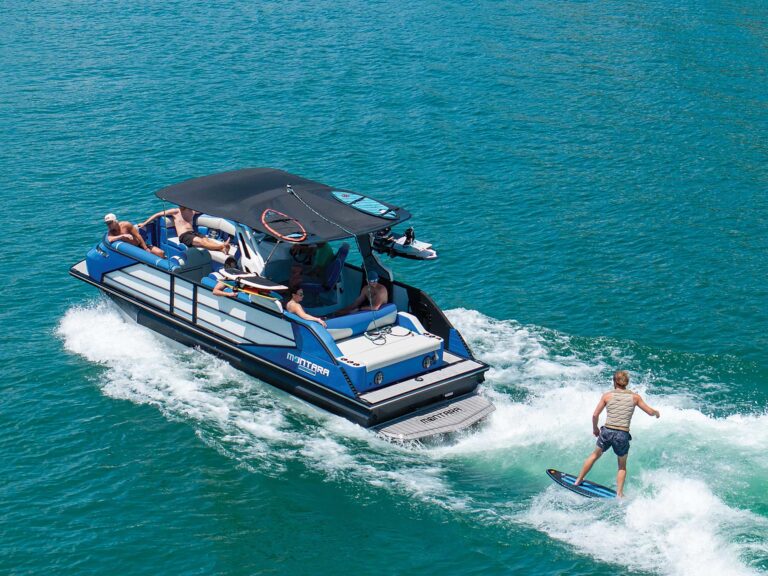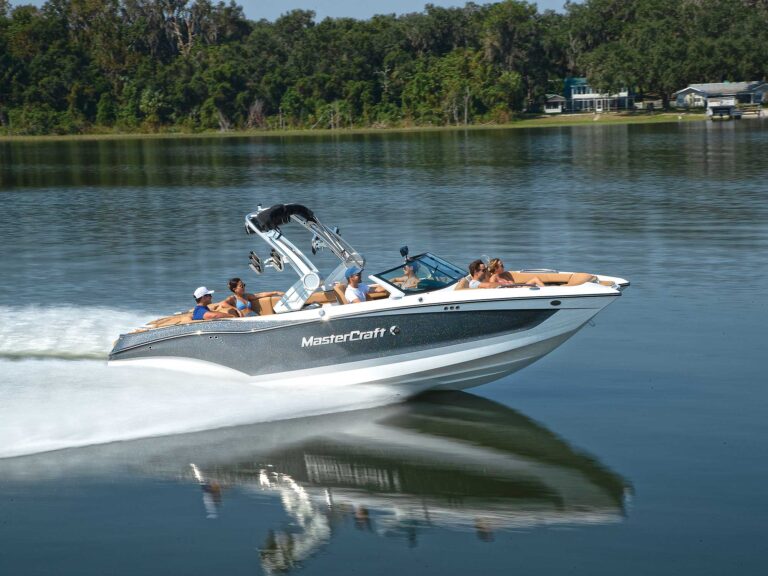As you progress toward the flips and past the wake jumps you will find you need a different edge for two families of moves: heelside tantrums and toeside front rolls. They need a special edge involving an edge change to make the move work properly. Changing your edge quickly from one to the other gives you a “trip” feeling as if you were hitting a curb on roller skates or a skateboard. That is where the term “trip flip” comes from.
Feeling the Trip
Most people can do a simple back flip off a diving board, dock or boat, or on a trampoline. A tantrum is basically that same standing back flip. You have to square up to the wake so your back is facing the wake and your shoulders are in line with the boat’s path. With a normal progressive edge you can’t get into this position. When you edge progressively into the wake your shoulders are perpendicular to the wake. This is not the ideal position for a tantrum. In order to get your shoulders parallel to the boat path and square up, you have to stop your edge and switch directions a little.
Think of what happens when you edge toward the wake heelside, but then you do a U-turn and edge back out toeside. At the halfway point between the edge in and edge out, your board and body are square to the wake and boat path. This is the same takeoff position you need for the tantrum. The catch is you need to do it very quickly at the wake and with enough momentum to carry you across the two wakes while flipping. It is good practice to take the wake out of the picture and change edges out in the flats as if you were going to do the trick with no wake. Edge hard away from the wake on your heelside edge and then flatten off and coast. As you go flat, let go with your back hand. As you coast flat, try to switch to your toeside edge quickly and find the tripping motion. When you find it you will be thrown off balance, or you might even fall as if you were tripping over something.
As you get this motion down, you have to put the wake back into the picture. Let’s make the wake the curb. When you hit it and stop, you will get tripped just like you practiced in the flats. The bonus is that the wake has the energy to push you up if you hit it tall. It is more natural to stop and straighten your legs, but you have to learn to stop and keep your knees bent at the same time. If you stop and straighten your legs before you get to the wake, you will start to flip too early and you will not be able to push off the top to get the needed height to perform the maneuver.
Tripping for Tantrums
Now that you have the technique, let me take you through the move from the beginning. Take a wide approach. Since you are switching edges you will lose some speed, so be aggressive. It is better to overrotate than underrotate, and your ankles will thank you. As you coast out into the flats, bend your knees and get ready to edge hard. Take a pretty fast turn, unlike the progressive edge, and build a lot of speed at the beginning.
About three feet before the foam in front of the trough of the wake, you should release your back hand and stop edging and flatten out, making sure to keep your knees bent as you stop. Begin your turn back out as if you were making the U-turn quickly, and get your body over your toes at the bottom of the wake. This all happens very fast and it may take a couple of attempts to get your timing and technique. As you stop in good position, square up your shoulders, stand tall to get your pop and then tuck your knees in to flip back. It is better to do a back tuck rather than a back layout. Back layouts cause too many problems with edging and grabs down the road. As you flip, spot the next wake. Land and keep your direction away from the wakes.
Tripping for Front Rolls
The same technique is used for the toeside front roll, but the trick is initiated with two hands because you aree facing the wake. With the front roll you have to cock your shoulders back far as you go flat before the wake. This motion allows you to go up first, then flip after you get the height you need.
It is easier to learn a front roll to fakie (aka scarecrow) first because of the heelside landing, but it causes rotational problems and bad habits long term. If you learn the scarecrow first, chances are the board will go around the back instead of straight over the top and to say the least it’s ugly. For the front roll you have to put a lot into the rotation and get back over your toes so you can edge out of the trick. Try to find both ends of the spectrum, underrotating and overrotating.
Don’t Get Tripped Up
The most common problem with these two tricks is edging too long. Since everyone is more used to holding their edge progressively, it is hard to adjust to the trip-flip edge. For the tantrum, make sure you let go of your back hand early, which will help you stop edging. For the front roll, get those shoulders back as if you were cocking a gun and then pull the trigger off the top. If you don’t, you will dive forward without going up and land on your butt every time. If you edge progressively, your board will go around the back on both tricks instead of straight over the top. This makes the rope very tight and hard to manage. Edge hard. Stop. And pop!
There are many tricks related to these two tricks, and you even use a little of the trip-flip motion for some off-axis spins. After you learn this type of edge, don’t forget to distinguish between trip flips and the progressive edge tricks. If you use the wrong edge for a trick you will have problems.

